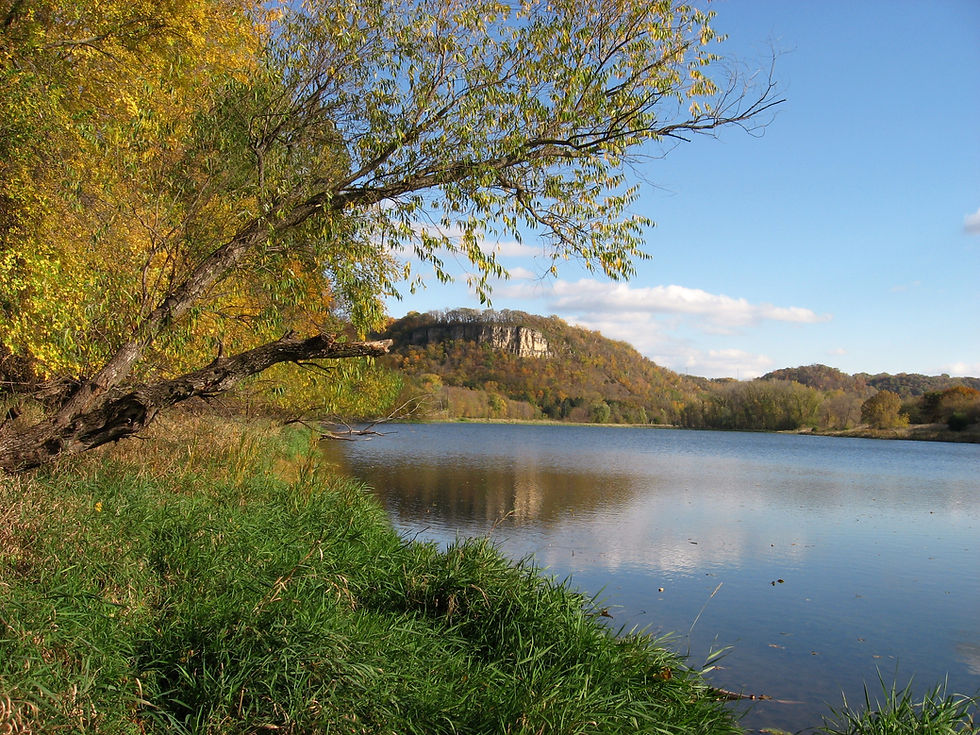The Green Wave
- wacoutanaturenotes
- May 6
- 3 min read
As we traveled further through the month of April, we were treated to periodic rain events which helped to alleviate the drought conditions. The moisture initiated the transformation of the landscape from a drab brown to a soft subtle green.
At the same time, we started to observe fresh woodland flora and new migrant birds announcing the definite arrival of spring.

The most notable early sign of spring in our neighborhood besides the green grass and dandelions was watching the numerous willow trees along the river leaf out.

On April 28th, we dodged a bullet from all the serious storms that had been predicted for the previous three days. The most exciting and dramatic observation was the amazing rainbow over Wacouta and Rattlesnake Bluff.

One of the very first signs of life I discovered on the forest floor in our neighborhood was the colorful scarlet elf cup fungi. This fungus grows on decaying sticks in damp locations usually buried under leaf litter.

One of the first "spring ephemerals" I observed in our neighborhood in April was the bloodroot. This fragile spring wildflower opens in full sunlight and closes at night.
These plants have to flower and reproduce before the forest canopy closes preventing sunlight from reaching the forest floor. The underground stem has red sap and was used by Native Americans as a dye for clothing and baskets. Hence the name bloodroot.

The first migrating songbird we observed in our yard was the Yellow-Rumped Warbler on April 14th.
These are some of the most visible warblers and are found in open woodlands and brushy habitats. The yellow rumps become exposed as they flit from branch to branch in search of insects.
Here is a list of other spring migrants we observed and arrival date.
Rufous-Sided Towhee April 18
White-Throated Sparrow April 20
Catbird April 28
Blue Jay April 28
House Wren April 29
Baltimore Oriole April 29
Rose- Breasted Grosbeak April 30
Palm Warbler April 30
Ruby-Throated Hummingbird May 1

One of the most interesting observations at our feeders this spring occurred on April 28 and 29. On those days, we had migrating flocks of blue jays. The most we observed at any one time was 12.
This phenomenon last only a day or two. One morning in the spring of 2024, we observed 21 at one time. One morning late last week, I was fortunate to watch a blue jay remove and consume a 6 inch nightcrawler before flying away.

In the early morning of May 4th, I paddled my canoe up into Wacouta Bay to observe what new signs of spring were present. One observation was the number of waterfowl was greatly reduced from two weeks earlier.
No doubt the presence of a new 150 to 200 foot beaver dam was something I didn't expect. The dam was located at the mouth of Bullard Creek. When I had paddled in that area on April 23rd, the water level was almost 2 feet lower preventing me getting close to the dam.
With the new dam holding back a considerable amount of water, a large new lodge is under construction.

On March 10, 2025, I heard the first calls of migrating cranes overhead. In some cases, the cranes were flying so high it was difficult to even see them.
I have paddled up into the bay numerous times over the past 25 years and have never observed an active crane nest. That was until May 4th, when I came across this nesting crane hidden among the aquatic sedge vegetation. If you zoom in on the attached photo, you will see one large egg on the nest.

Sandhill cranes generally lay two eggs. Unfortunately, in most cases only one chick survives to fledge. Both sexes care for and protect the young colt.

Crane nests are typically built of grasses or other aquatic vegetation on the ground or in shallow water. In the case, if the river rises quickly this nest could be abandoned.




Hi Bruce,
I love reading your blogs. Another interesting thing to follow for bird watchers right now is Mayo Clinic’s Peregrine Falcon Program. In case readers are not familiar, it’s a live look into Hattie and Orton’s nesting box mounted at Mayo Clinic Rochester. They have 2 chicks this year. They grow so incredibly fast! There is also a lot of info on Peregrine Falcons as well. The link is below if anyone has interest.
https://history.mayoclinic.org/falcon-program/
Another interesting cometary! Keep it going Bruce, we need to be grounded and appreciate the beauty of nature around us in turbulent times like we are experiencing this year.
ahh, Spring!
You have captured so many awesome pictures, thank you for sharing with us